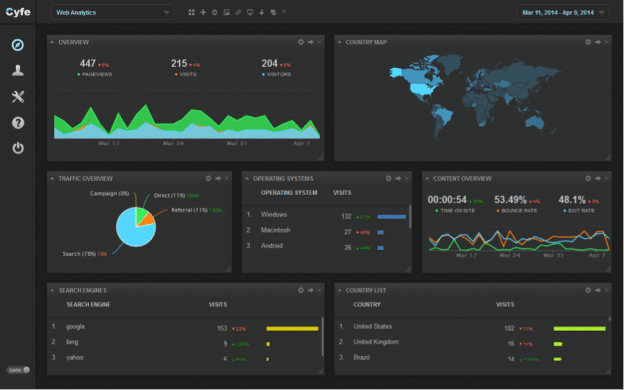
- The Pro of managing an ecommerce business: it’s entirely measureable!
- The Con of managing an ecommerce business: it’s entirely measurable (and those metrics need to be tracked and interpreted). Ugh…
Ecommerce metrics, or KPI’s (key performance indicators), are legitimate game-changers provided you know which ones demand your focus. But before we get too far ahead of ourselves, let’s kick things off with this in mind:
You can’t manage what you can’t measure,
and you can’t improve what you can’t manage.
- Peter Drucker (paraphrased)
This axiom permeates throughout all aspects of digital marketing, but is especially poignant when it comes to ecommerce solutions that directly boost the bottom line.
Sales are the name of the game and if there’s a way to measure how your audience responds to your online store and how that might affect your revenue, then it’s worth using those metrics to your advantage.
The data is available; it’s only a matter of investing time into understanding what to measure and how to interpret those measurements that may stand between you and your online business’ next big shift to greatness.
How to Begin Tracking Ecommerce Metrics
Get a baseline. Start off by understanding where you are right now. See if you notice any trends or interesting data. If something surprises or confuses you (for better or worse) make a note of it. Diving into data won’t do very much if you don’t have a firm baseline from which to measure against. So, it’s helpful to get a quick point of reference and determine which data points interest you the most.
Stick with a consistent measurable time frame. While looking at actionable ecommerce data on a daily basis is a reasonable goal to work towards, to begin it’s more important to grasp the bigger sales trends at play. Days and even weeks can be volatile, so breaking measurements out into monthly data, or more specifically, groupings of weeks (because months often end at mid-week) will be most helpful.
Example: Collect and review data every Monday through Sunday and then evaluate the overall picture over a four-week span of time.
Define your goals. Who are any of us kidding? When it comes to running an ecommerce-based business, the top goal is likely to increase sales. We get it and we support it! However, in order to drive your bottom line, you may need to boost your website traffic and boost conversion rates and boost click-through rates…it goes on and on, but it’s helpful to start off by defining some (small) goals. Have an attainable target or targets in mind. Then, as you learn more, you can (and should) adjust and add.
Which Ecommerce Metrics Matter Most?
The answer you don’t want to hear is that it depends. But really, your professional business goals will dictate what matters most to you, your customers, and your bank account. That said, here’s a rundown of what are typically the most relevant ecommerce metrics to track and understand. Ready? Let’s dive into some data…
#1 Ecommerce Metric: Total Ecommerce Site Traffic
This is, after all, a numbers game. More website visitors equal more sales conversions (more on that later), so start by understanding the big picture. More specifically…
- How many people visit your website each month?
- Where are these folks coming from? Are they finding your website through digital marketing ads, social media networks, Google searches?
- How long are visitors staying on your site?
- What is their journey? Which pages are they visiting and in what order?
- What is your ecommerce site’s bounce rate? (Bounce rate measures the percentage of viewers who leave — or bounce — after viewing only one web page).
Having this ongoing snapshot view of your ecommerce site will help guide you to better decision-making when it comes to marketing, advertising, and design — ultimately getting a better understanding of your audience and how to best sell to them.
And speaking of your audience…
#2 Ecommerce Metric: Audience Analysis
It’s essential to know exactly who your audience is so you can understand how to best engage them and sell to them. Things to measure:
- Age, sex, location? Getting a grasp of audience demographics makes a tremendous difference from a sales perspective. Are these rural or city folks? Can their geographical location tell you anything about their annual income or how much they might be willing to spend on your services? Different messaging should be used to target specific audiences.
- Time of day? Is your audience more apt to shop in the wee early hours on Thursdays? Are they weekend afternoon shoppers? If you don’t know, you can’t target and make the most of these timely opportunities.
- Seasonality? Do you get more visitors during the holidays? Major sales events? Is yours a seasonal business? This info will inform your marketing strategy and let you know what’s working or flubbing, so know these answers cold.
- Device type? Are people viewing your site through mobile devices, laptops, phones, and what kinds? This is good to know so you can tweak your ecommerce site design to maximize your viewer’s user experience and most efficiently lead them to your call to action.
Here’s a sample web analytics dashboard from Cyfe that analyzes audience demographics at a glance. Number of visitors, geographic location, and more are featured in this custom dashboard.

#3 Ecommerce Metric: Conversion Rate
This is the big one. Because you’ve been so astute and already know your total ecommerce site traffic (see #1 Ecommerce Metric), you can figure out your total conversion rate by measuring how many of those site visitors make a purchase. Divide your number of sales by total visitors and voila! you have your conversion rate. Your sales conversion rate instantly measures your ecommerce success or shortcomings, so get on this metric fast.
EXPERT TIP: Once you become an ecommerce metric master, you can track conversion rates from all different sources to determine which sources of traffic are most profitable to your company.
Dive into sales that convert from visitors who came from each source of traffic and pit them against each other. Such as LinkedIn vs. Facebook vs. Reddit vs. email vs. organic search. All of these will help you determine your overall marketing strategy.
To start, focus on increasing your conversion month-over-month.
#4 Ecommerce Metric: Average Order Value (AOV)
Hopefully it’s a given that you should know how much revenue you’re bringing in on a regular basis. Assuming you have that key data, check out your AOV next. AOV tells you the average of how much your buyers are spending per order. It’s up to you to determine what’s spending a little vs. what’s spending a lot, but knowing your AOV will dictate your next steps.
Example: If you have a lot of ecommerce site visitors spending a little cash, you need a lot more visitors to earn more cash. Conversely, if you find that visitors are spending a great deal on one or two items, perhaps it’s time to rethink how to either focus your marketing strategy on those products or to sell related add-ons that will keep your AOV on an upward trajectory.
#5 Ecommerce Metric: Shopping Cart Abandonment Rate
Understanding your customer’s journey through your ecommerce site is perhaps most relevant at the final point of sale — the shopping cart. It is (unfortunately) common for shoppers to fill up their cart and hit the road before confirming a final purchase. It’s naturally in the best interest of online business owners to avoid this!
Some (kind of) good news: The average shopping cart abandonment rate for major corporations is a whopping 69%, so don’t be alarmed if you think yours is high. The key here again is the act of measuring data. Knowing your shopping cart abandonment rate is half the battle. If you know what it is, you can work at reducing it. How you reduce it is up to you. You might find that you need to adjust your messaging, reminders, or your targeted email marketing campaigns, if that’s your thing. But remember that you can’t do anything worthwhile, other than guess, without first analyzing the metrics.
Stop Guessing! Use Ecommerce Metrics.
There are infinite more ecommerce metrics to study up and learn, but these five will kick you off in the right direction before you’re ready to tackle more.
Know this: ecommerce metrics, perhaps more than any other digital marketing metrics, are directly linked to your bottom line. They are incredibly powerful insights into your audience that are immediately actionable and should be taken very seriously.
If you’re not measuring your ecommerce site metrics, you’re guessing. And sure, you’re smart and you can probably make some fairly intelligent guesses, but the data will undoubtedly guide you to eliminating costly errors. So, what are you waiting for? Get in there, get the data, and get the sales!
Not sure what metrics you need to be measuring for your ecommerce goals? Check out our FREE Beginner’s Guide to Choosing the Right Marketing KPIs for Your Business.



